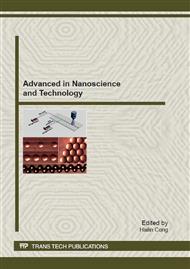p.132
p.136
p.141
p.146
p.150
p.155
p.160
p.165
p.172
Optical and Structural Properties of Yb-Doped ZnO Thin Waveguide Films with Er+ Ions Implantation
Abstract:
Yb-doped ZnO optical waveguide thin films were deposited on sapphire substrates by radiofrequency (RF) magnetron sputtering technology, and then Er+ ions with the energy of 200 KeV were implanted into the as-deposited films, the implantation dose was 1×1015 ions/cm2. Optical waveguide properties and film thicknesses were studied by prism coupling method. Film thicknesses, element components and Er+ ions range distrbution were studied by Rutherford backscattering (RBS) technique. The basic structure and phase of the films were studied using X-ray diffraction (XRD). The properties of optical frequency upconwersion were investigated by fluorescence spectrometer. The results demonstrated that the Yb-doped ZnO films with Er-implantation have planar waveguide structure and the waveguide properties were changed compared with the virgin ZnO films. The effective refractive indices of the films decreasing with the amount of Yb-doped concentration increasing. Yb concentration in films associated with targets but more than that in them. The films shown the classic structure of c-axis preferred orientation. The compounds of Yb:Zn and Er:Zn were appeared in the films. Inspired the films by 980 nm laser in room temperature, stimulated optical emission between 300~720 nm was not observed.
Info:
Periodical:
Pages:
150-154
Citation:
Online since:
February 2012
Keywords:
Price:
Сopyright:
© 2012 Trans Tech Publications Ltd. All Rights Reserved
Share:
Citation:


